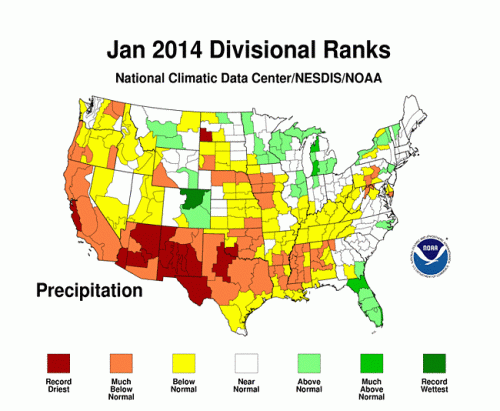News•February 13, 2014
Never-Ending Winter? Nah, January in U.S. Was Average

By Brian Kahn
It might seem like the East Coast has endured a never-ending winter, but that was hardly the case for the Lower 48 in January. According to new data released Thursday by the National Climatic Data Center, the nation was extremely dry and only slightly cooler than average for the first month of 2014.
The average temperature of the U.S. was just 0.07°F below the 1981-2010 average according to NCDC. That makes it the 52nd-coldest winter since recordkeeping began 120 years ago.
A map showing the records set for daily high versus daily low temperatures in January 2014.
Credit: National Climatic Data Center

While recent cold temperatures may seem unusual, climate data shows that extreme cold weather events are occurring far less frequently in the continental U.S. than they used to. This is largely related to winter warming trends due to manmade global warming and natural climate variability.
January temperatures were noteworthy for the sharp split in weather patterns in the country. The beginning and end of the month were marked by the now famous polar vortex, which brought freezing Arctic air over the eastern half of the U.S. However, a persistent blocking pattern off the California coast kept the western half of the country sunny and warm.
The map of average temperatures across the country underscores the divide. Texas was the only state west of the Mississippi River to experience below-average temperatures in January, and even then it was only in the eastern half of the state. The Southeast experienced its 8th-coldest January on record while the trio of Arizona, California and Nevada experienced their combined 3rd warmest. However, not a single state experienced its record warmest or coldest January in 2014.RELATEDJanuary’s Temps Leave a Nation Blowing Hot and Cold
In U.S., Winters Warming but Precipitation More Nuanced
‘Atmospheric River’ May Put a Dent in California Drought
Despite the surge of warmth in the West, record daily lows outpaced record daily highs in January by more than a 2-to-1 margin thanks to two blasts of cold weather at the beginning and end of the month.
Outside of the contiguous U.S., Alaska also baked in January. The state had its 3rd-warmest January, with temperatures 14.8°F above average. During a late January warm spell, the daily high reached 62°F in Port Alsworth, tying the highest January temperature recorded in the state.
The month was also notable for the dry conditions that dominated a stretch of states from California to Alabama. After having its second-driest December on record, California was once again one of the most parched states in the country. This January was its third-driest January on record. Within the state, Los Angeles didn’t see a drop of rain for the entire month and Sacramento ended a 52-day dry spell on January 29.
A map showing precipitation for January 2014 by climate divisions. New Mexico had its driest January on record.
Credit: National Climatic Data Center

Combined with December, California’s drought worsened. It had its driest December-January period on record. Less than an inch of rain fell across the two months, which is bad news in a state that receives 75 percent of its precipitation over the winter.
The arid weather helped trigger offseason wildfires in the hills of Los Angeles and the outskirts of Sequoia National Park. It also left the Sierra Nevada Mountains, which provides about a third of California’s water supply, more brown than white. Snowfall in the Sierra Nevada was so scant in January that Hawaii’s Mauna Kea recorded higher snow totals when a storm dropped 12 inches of snow there over the last few days of January.
With rising concerns about continuing dry weather, Governor Jerry Brown declared a State of Emergency on January 17 to give state water officials more flexibility to manage their supplies and provide assistance to farmers and others whose livelihoods are directly impacted by the drought.
While much of the focus has been on California’s drought, the epicenter for dry conditions in January was New Mexico, which experienced its driest January on record. The state only received 0.03 inches of precipitation, 5 percent of its average precipitation for the month. Neighboring, Arizona wasn’t far behind as it had its second-driest January. Locations around the state were incredibly dry including Flagstaff, which went 39 days with a drop of rain or snow from December 22-January 29, the longest winter dry stretch recorded in the city.
California’s drought may ease a little after an atmospheric river brought rain and snow to the northern half of the state last week. Some parts of the Bay Area received more rain from that storm than they saw in all of 2013. Much of that moisture bypassed the southern half of the state as well as Arizona and New Mexico. A new storm this weekend could provide further relief for northern California and Oregon while again leaving southern California and the lower half of the Four Corners dry, heightening concerns for summer water availability as well as increasing odds for a more explosive wildfire season.
You May Also Like
Northeast Braces for Latest Blast of Brutal Weather
Study Sounds ‘El Nino Alarm’ for Late This Year
White Roofs Could Offset Summer Warming by 2100
Winter Olympics Inadvertently Adapting to Climate Change
63 Years of Global Warming in 14 Seconds
Record Number of Billion-Dollar Disasters Globally in 2013